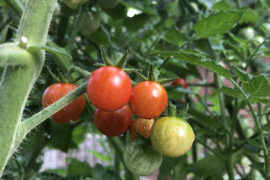One part of gardening that is often forgotten is the beneficial bugs that help us pollinate, recycle nutrients, maintain healthy soil, and control other pests. Protecting insects is very important to our crops and flowers.
Kids are fascinated with our bug friends in the garden. Hopefully, you can introduce “good” insects to children before they develop phobias about them. Talking about the bugs and their habitats and how they help gardens can make the bugs seem less threatening to children.
Here are some helpful critters that are usually easy to spot in and around a garden:
Ladybugs are the best defense against aphids, mealy worms, and mildew. They are probably one of the most popular insects being glorified in books, movies, cartoons, and children’s clothing. Check out The Grouchy Ladybug by Eric Carle and The Life Cycle of a Ladybug by Colleen Sexton. There are over 6,000 species of ladybugs. Inviting ladybugs into your garden is very advantageous all around!
Bees, of course, are our friends! It’s so important to teach children about bees as they are responsible for just about one in every three bites of food we eat according to seewhatgrows.org. How can you get kids motivated about saving the bees? Start by talking to beekeepers about their job. Observe and draw bees during a special walk. Try some honey and talk about the fresh honeycomb. You can even try different types of honey while explaining about gathering nectar from different blossoms!
Dragonflies also fall under advantageous insects. Dragonflies can manage a wasp population and are a predator to flies, mosquitoes, and other garden pests. The beauty of dragonflies has inspired art and even Disney as Evinrude is a character in the 1977 movie, The Rescuers as a boat driver of small animals. What an imagination someone had!
The spine-soldier bug is also a threat to predators. Their cousins are the odorous stink bugs. They attack caterpillars, potato bugs, flea beetles, moths, army worms, and more. When not busy attacking predators, this soldier bug will feed on plant sap without ever harming the plant itself. This beneficial bug has a sweet tooth!
Fireflies or lightening bugs are actually beetles. They glow under their abdomens, usually in summer months. The light is used to deter predators, attract mates, and attract food. They live in woodland edges, fields, and meadows. Their habitat is becoming scarce. Save the fireflies!
Are ants good for the environment? Well, not if you are standing in an ant bed; however, ants allow water and oxygen to get to the roots of plants. Ants may take seeds down into the soil so that they germinate. They actually control termites and are also food for birds. There are several varieties of ants, so make sure that you have a helpful variety around your home.
Butterflies are nature’s beauties. They are also great pollinators. If you plant a butterfly garden, your garden will attract birds and bees, meaning you have a healthy garden. You might talk to children about the life cycle of a butterfly. This helps them understand how everything is important to one another. Butterflies actually make us happy!
How to Teach Kids About Insects:
• Supply books and resources (fiction and non-fiction).
• Make a bug box from an old shoe box with grass and twigs in the bottom to observe bugs for a bit (and then let them go to back their homes).
• Buy a bug kit.
• Help kids identify the bugs they find.
• Use color sheets to identify parts of the insects.
• Count the legs and talk about how all true bugs have six legs.
• Purchase a butterfly kit or an ant farm at local toy store or amazon.
• Discuss how bees and butterflies help plants grow and fruit ripen.
• Research the bugs that the children are around.
• Teach them about the purpose of insects and our ecosystem.
Stop before you kill a bug, and as always, happy gardening!
Gaye Winter, Ph.D., teaches English at Mississippi Gulf Coast Community College and is a member of Biloxi Garden Club. Reach her at gaye.winter@mgccc.edu.





